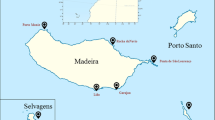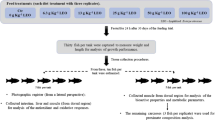Abstract
The aim of this study was to determine the differences in the nutritional properties of wild and cultured loach Misgurnus anguillicaudatus obtained from southern Japan. Major parameters, such as whole-body proximate composition, lipid classes, and fatty acid and amino acid composition, were investigated. The whole-body total lipid content of cultured loach was twofold higher than that of wild loach and the proportion of neutral lipids was significantly higher in cultured loach than in wild loach. However, the polar lipid content was two- to threefold lower in cultured loach than in wild loach. Compared to the wild loach, higher contents of 20:5n-3 and 22:6n-3 were detected in cultured loach, but much lower contents of 20:4n-6. In terms of whole-body amino acid composition, wild and cultured loach showed similar profiles. In conclusion, the consumption of cultured loach will contribute to dietary n-3 highly unsaturated fatty acids intake, with a benefit to human health.
Similar content being viewed by others
References
Kiros S, Aoki J, Park CB, Soyano K (2011) Annual changes in testicular development and plasma sex steroids in the captive male dojo loach Misgurnus anguillicaudatus. Ichthyol Res 58:217–224
Arai K, Matsubara K, Suzuki R (1993) Production of polyploids and viable gynogens using spontaneously occurring tetraploid loach, Misgurnus anguillicaudatus. Aquaculture 117:227–235
Arias-Rodriguez L, Yasui GS, Kusuda S, Arai K (2010) Reproductive and genetic capacity of spermatozoa of inter-populational hybrid males in the loach, Misgurnus anguillicaudatus. J Appl Ichthyol 26:653–658
Yasui GS, Fujimoto T, Sakao S, Yamaha E, Arai K (2011) Production of loach (Misgurnus anguillicaudatus) germ-line chimera using transplantation of primordial germ cells isolated from cryopreserved blastomeres. J Anim Sci 89:2380–2388
Zhou XY, Li MY, Abbas K, Wang WM (2009) Comparison of haematology and serum biochemistry of cultured and wild Dojo loach Misgurnus anguillicaudatus. Fish Physiol Biochem 35:435–441
Arai K (2003) Genetics of the loach, Misgurnus anguillicaudatus: recent progress and perspective. Folia Biol (Krakow) 51:107–117
Morishima K, Nakayama I, Arai K (2008) Genetic linkage map of the loach Misgurnus anguillicaudatus (Teleostei: Cobitidae). Genetica 132:227–241
You CH, Yu XM, Tong JO (2009) Detection of hybridization between two loach species (Paramisgurnus dabryanus and Misgurnus anguillicaudatus) in wild populations. Environ Biol Fish 86:65–71
Montero D, Izquierdo MS, Tort L, Robaina L, Vergara JM (1999) High stocking density produces crowding stress altering some physiological and biochemical parameters in gilthead seabream, Sparus aurata, juveniles. Fish Physiol Biochem 20:53–60
Montero D, Robaina LE, Socorro J, Vergara JM, Tort L, Izquierdo MS (2001) Alteration of liver and muscle fatty acid composition in gilthead seabream (Sparus aurata) juveniles held at high stocking density and fed an essential fatty acid deficient diet. Fish Physiol Biochem 24:63–72
Bligh EG, Dyer WJ (1959) A rapid method for total lipid extraction and purification. Can J Biochem Physiol 37:911–917
AOAC (1990) Official methods of analysis of the Association of Official Analytical Chemists, 15th edn. Association of Official Analytical Chemists, Arlington
Juaneda P, Rocquelin G (1985) Rapid and convenient separation of phospholipids and non-phospholipids from rat heart using silica cartridges. Lipids 20:40–41
Floreto EAT, Teshima S, Koshio S (1996) The effects of seaweed diets on the lipid and fatty acids if the Japanese disc abalone Haliotis discus hannai. Fish Sci 62:582–588
Teshima S, Kanazawa A, Yamashita M (1986) Effects of dietary phospholipids on lipid transport in the juveniles prawn. Nippon Suisan Gakkaishi 52:159–163
Teshima S, Kanazawa A, Yamashita M (1986) Dietary value of several proteins and supplemental amino acids for larvae of the prawn, Penaeus japonicus. Aquaculture 51:225–235
Saito H, Okabe M (2012) Characteristics of lipid composition differences between cultured and wild ayu (Plecoglossus altivelis). Food Chem 131:1104–1115
Bell JG, Preston T, Henderson RJ, Strachan F, Bron JE, Cooper K, Morrison DJ (2007) Discrimination of wild and cultured European sea bass (Dicentrarchus labrax) using chemical and isotopic analyses. J Agric Food Chem 55:934–5941
Grigorakis K, Alexis MN, Taylor KDA, Hole M (2002) Comparison of wild and cultured gilthead sea bream (Sparus aurata); composition, appearance and seasonal variations. Int J Food Sci Technol 37:477–484
Grigorakis K, Taylor KDA, Alexis MN (2003) Organoleptic and volatile aroma compounds comparison of wild and cultured gilthead sea bream (Sparus aurata): sensory differences and possible chemical basis. Aquaculture 225:109–119
Komilus CF, Shichi N, Koshio S, Ishikawa M, Yokoyama S, Michael FR, Gao J, Makita C (2008) Influences of palm oil blended with fish oil on growth performances and lipid profiles of red sea bream Pagrus major. Aquac Sci 56:317–326
Olsson GB, Olsen RL, Carlehog M, Ofstad R (2003) Seasonal variations in chemical and sensory characteristics of farmed and wild Atlantic halibut (Hippoglossus hippoglossus). Aquaculture 217:191–205
Neff BD, Cargnelli LM (2004) Relationships between condition factors, parasite load and paternity in bluegill sunfish, Lepomis macrochirus. Environ Biol Fish 71:297–304
Davidson J, Bebak J, Mazik P (2009) The effects of aquaculture production noise on the growth, condition factor, feed conversion, and survival of rainbow trout, Oncorhynchus mykiss. Aquaculture 288:337–343
Karapanagiotidis IT, Bell MV, Little DC, Yakupitiyage A, Rakshit SK (2006) Polyunsaturated fatty acid content of wild and farmed tilapias in Thailand: effect of aquaculture practices and implications for human nutrition. J Agric Food Chem 54:4304–4310
Vijayan MM, Ballantyne JS, Leatherland JF (1990) High stocking density alters the energy metabolism of brook charr, Salvelinus fontinalis. Aquaculture 88:371–381
Arakawa T, Ishizaki Y, Chuda H, Shimizu K, Arimoto M, Takeuchi T (2002) Comparison of lipid classes and fatty acid compositions between hatchery reared and wild caught yellowtail Seriola quinqueradiata juvenile. Nippon Suisan Gakkaishi 68:374–381
Poston HA (1991) Response of rainbow-trout to soy lecithin, choline, and autoclaved isolated soy protein. Prog Fish Cult 53:85–90
Geurden I, Radunzneto J, Bergot P (1995) Essentiality of dietary phospholipids for carp (Cyprinus carpio L.) larvae. Aquaculture 131:303–314
Uyan O, Koshio S, Ishikawa M, Uyan S, Ren TJ, Yokoyama S, Komilus CF, Michael FR (2007) Effects of dietary phosphorus and phospholipid level on growth, and phosphorus deficiency signs in juvenile Japanese flounder, Paralichthys olivaceus. Aquaculture 267:44–54
Wang LW, Shimizu Y, Kaneko S, Hanaka S, Abe T, Shimasaki H, Hisaki H, Nakajima H (2000) Comparison of the fatty acid composition of total lipids and phospholipids in breast milk from Japanese women. Pediatr Int 42:14–20
Rodriguez C, Acosta C, Badia P, Cejas JR, Santamaria FJ, Lorenzo A (2004) Assessment of lipid and essential fatty acids requirements of black seabream (Spondyliosoma cantharus) by comparison of lipid composition in muscle and liver of wild and captive adult fish. Comp Biochem Phys B 139:619–629
Palacios E, Racotta IS, Aparicio B, Arjona O, Martinez-Palacios CA (2007) Lipid classes and fatty acids during embryogenesis of captive and wild silverside (Chirostoma estor estor) from Patzcuaro Lake. Fish Physiol Biochem 33:81–91
Zhao F, Zhuang P, Zhang LZ, Shi ZH (2010) Biochemical composition of juvenile cultured vs. wild silver pomfret, Pampus argenteus: determining the diet for cultured fish. Fish Physiol Biochem 36:1105–1111
Kader MA, Koshio S, Ishikawa M, Yokoyama S, Nguyen BT, Gao J, Laining A (2011) Can fermented soybean meal and squid by-product blend be used as fishmeal replacements for Japanese flounder (Paralichthys olivaceus)? Aquac Res 43:1427–1438 doi:10.1111/j.1365-2109.2011.02945.x
Alam MS, Teshima S, Yaniharto D, Sumule O, Ishikawa M, Koshio S (2005) Assessment of reference dietary amino acid pattern for juvenile red sea bream, Pagrus major. Aquac Int 13:369–379
Ozyurt G, Polat A (2006) Amino acid and fatty acid composition of wild sea bass (Dicentrarchus labrax): a seasonal differentiation. Eur Food Res Technol 222:316–320
Badiani AP, Anfossi L, Fiorentini PP, Gatta M, Manfredini N (1996) Nutritional composition of cultured sturgeon (Acipenser spp.). J Food Compos Anal 9:171–190
Uyan O, Koshio S, Teshima S, Ishikawa M, Thu M, Alam MS, Michael FR (2006) Growth and phosphorus loading by partially replacing fishmeal with tuna muscle by-product powder in the diet of juvenile Japanese flounder, Paralichthys olivaceus. Aquaculture 257:437–445
Acknowledgments
The authors would like to extend their gratitude to those who have taken the time to critically review this manuscript. The authors also thank the Lab of Fish Genetics and Breeding, College of Fisheries, Huazhong Agricultural University, China for providing the fish. The research was partially funded by the Management Expenses Grants of the United Graduate School of Agricultural Sciences, Kagoshima University provided to S. Koshio.
Author information
Authors and Affiliations
Corresponding author
Rights and permissions
About this article
Cite this article
Gao, J., Koshio, S., Nguyen, B.T. et al. Comparative studies on lipid profiles and amino acid composition of wild and cultured Dojo loach Misgurnus anguillicaudatus obtained from southern Japan. Fish Sci 78, 1331–1336 (2012). https://doi.org/10.1007/s12562-012-0561-x
Received:
Accepted:
Published:
Issue Date:
DOI: https://doi.org/10.1007/s12562-012-0561-x




